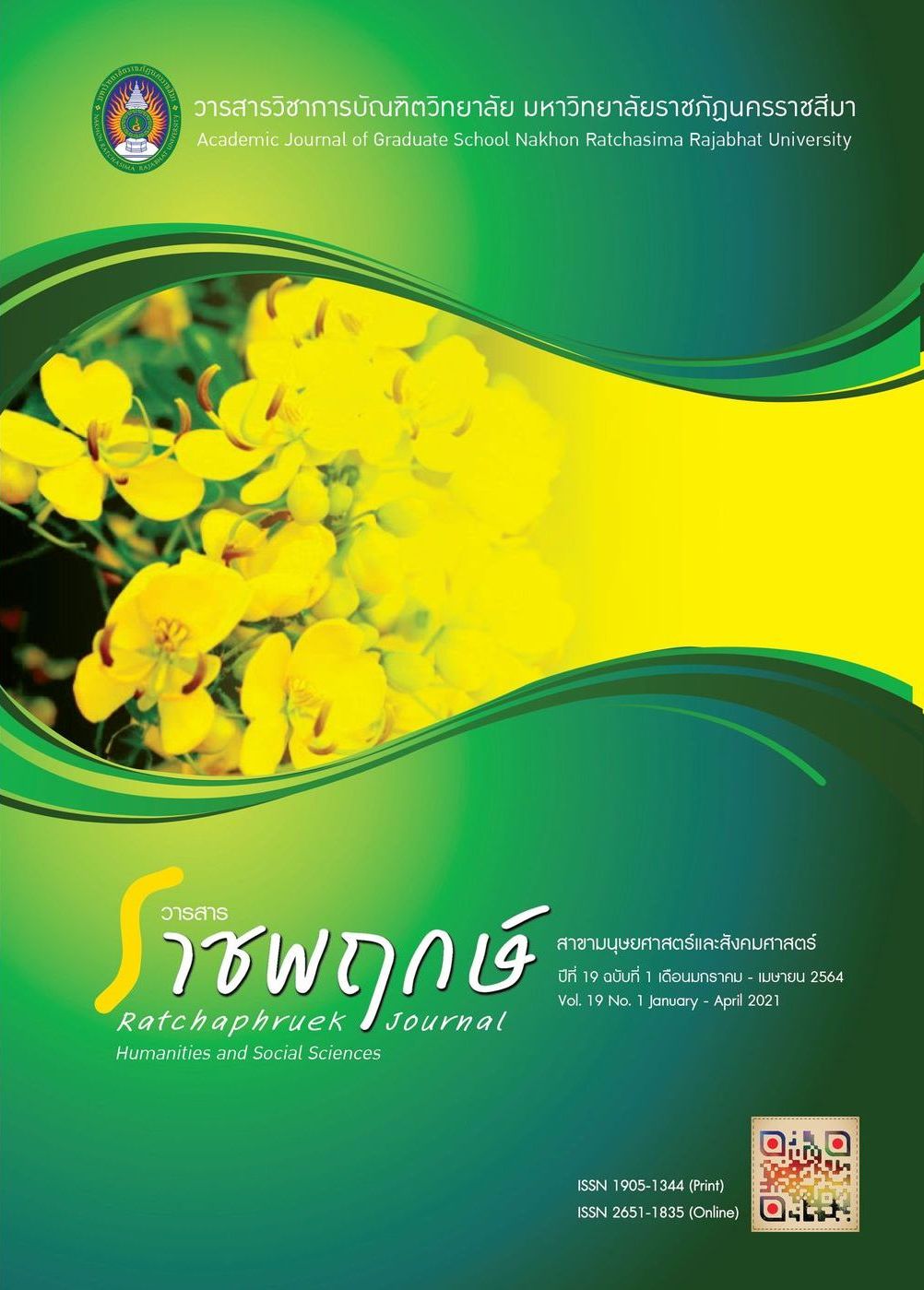Conditions and Demand Conditions Active Aging for Elder
Main Article Content
Abstract
This research aimed to study the conditions and demand conditions active aging for elder academic service in Nakhon Ratchasima Rajabhat University. The mixed methodology was used and divided into 2 issues. 1) Studying of conditions and demand conditions active aging for elder academic service in Nakhon Ratchasima, a qualitative research. The sample group for this research was a representative of government agencies such as Provincial Administrative Organization of Nakhon Ratchasima, Office of Social Development and Human Security of Nakhon Ratchasima, Nakhon Ratchasima Provincial office of the Non-Formal and Informal Education, the subdivisions of the sub-district including sub-district and administrative organizations
in Nakhon Ratchasima. Fifteen people were selected by purposive sampling. The study tool was the in-depth interview. The data was analyzed by Content analysis. 2) Studying of conditions and demand conditions active aging for elder academic service in Nakhon Ratchasima, a quantitative research. The samples were 400 elder
people (up to the age of 60) in Nakhon Ratchasima using table of Krejcie & Morgan. The study tool was questionnaire. The data were analyzed by percentage, mean, and standard deviation.
Research findings showed that: 1) in the part of educational services, the goal should be to enable the elder to meet their demands on health, mental, complementing, career advancement, and the ability to transfer their knowledge; and 2) overall, the levels and needs of active aging for elder were very high. When
considering each aspect, it was found that the most demanding aspect was the quality of life, followed by the power of education, respectively.
Article Details
References
กระทรวงพัฒนาสังคมและความมั่นคงของมนุษย์. (2550). ความรู้เกี่ยวกับผู้สูงอายุ. กรุงเทพฯ : สำนักพระพุทธศาสนาแห่งชาติ.
กระทรวงศึกษาธิการ. (2551). พระราชบัญญัติส่งเสริมการศึกษานอกระบบและการศึกษาตามอัธยาศัย พ.ศ.2551. กรุงเทพฯ : สํานักงานส่งเสริมการศึกษานอกระบบและการศึกษาตามอัธยาศัย.
กิติพงษ์ ลือนาม. (2561). วิธีวิทยาการวิจัยทางการศึกษา. นครราชสีมา: โคราชมาร์เก็ตติ้งแอนด์โปรดักชั่น.
ฐาณญา สมภู่ และคณิต เขียววิชัย. (2562). การพัฒนารูปแบบการสร้างเสริมภาวะพฤฒิพลังของชมรมผู้สูงอายุไทย. วารสารวิชาการศิลปะศาสตร์ประยุกต์, 12(1), น. 35 – 45.
บุญชม ศรีสะอาด. (2554). การวิจัยเบื้องต้น. (พิมพ์ครั้งที่ 9). กรุงเทพฯ : บริษัท สุวีริยาสาส์นจำกัด.
บำรุงพงศ์ ชยันราพิพัฒน์. (2555). โครงการออกแบบสถานสงเคราะห์ผู้สูงอายุ คามิลเลียนโซเชียล เซ็นเตอร์ ราชสีมา (ปริญญาภูมิสถาปัตยกรรมศาสตร์มหาบัณฑิต, มหาวิทยาลัยเกษตรศาสตร์).
มหาวิทยาลัยราชภัฎนครราชสีมา. (2558). แผนยุทธศาสตร์มหาวิทยาลัยราชภัฎนครราชสีมา พ.ศ. 2557-2561 (ฉบับปรับปรุง กันยายน 2558). นครราชสีมา: มหาวิทยาลัยราชภัฏนครราชสีมา.
รัชฎา ฟองธนกิจ. (2558). การพัฒนารูปแบบการดูแลผู้สูงอายุโดยชุมชน. (ปริญญาปรัชญาดุษฎีบัณฑิต สาขาการบริหารการพัฒนา, มหาวิทยาลัยราชภัฏสวนสุนันทา).
วิภานันท์ ม่วงสกุล. (2558). การพัฒนาศักยภาพผู้สูงอายุที่อาศัยอยู่ตามลำพัง ด้วยแนวคิดพฤฒิพลัง. วารสารวิจัยสังคม, 38(2), น. 93 – 112.
สุรกุล เจนอบรม. (2534). วิทยาการผู้สูงอายุ. กรุงเทพฯ: ภาควิชาการศึกษานอกโรงเรียน คณะครุศาสตร์ จุฬาลงกรณ์มหาวิทยาลัย.
สำนักงานคณะกรรมการพัฒนาเศรษฐกิจและสังคมแห่งชาติ. (2552). เอกสารประกอบการประชุม เรื่อง การขับเคลื่อนการพัฒนาผู้สูงอายุอย่างบูรณาการ. กรุงเทพฯ.
Christian Eugene Ekoto and Prema Gaikwad. (2015). The Impact of Andragogy on Learning Satisfaction of Graduate Students. American Journal of Educational Research, 3(11), p. 1378-1386.
McClusky. (1975). Education for Aging: The Scope of the Field and Perception for the Future. In S.M. Grabowski, & W.D. Mason (Eds.), Learning for Aging. Washington D.C.


